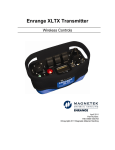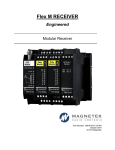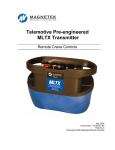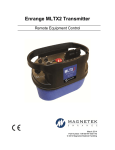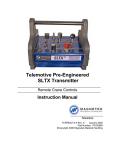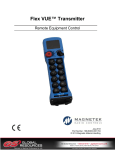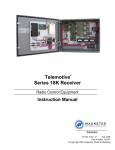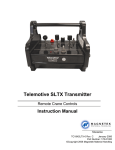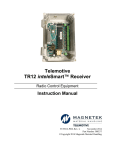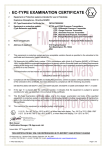Download Magnetek Enrange XLTX Technical information
Transcript
Enrange XLTX Transmitter (Intrinsically Safe) Wireless Controls April 2014 Part Number: 198-80202-1001 R0 ©Copyright 2014 Magnetek Material Handling Your New Radio Remote Thank you for your purchase of Magnetek’s Enrange TM brand XLTX Radio Wireless Controls. Magnetek has set a whole new standard in radio-remote performance, dependability, and value with this unique new line of bellybox transmitters. If your product ever needs modification or service, please contact one of our representatives at the following locations: U.S. Service Information For questions regarding service or technical information contact: +1.866.MAG.SERV +1.866.624.7378 International Service +1.262.783.3500 World Headquarters: Magnetek, Inc. N49 W13650 Campbell Drive Menomonee Falls, WI 53051 Telephone: Website: e-mail: +1.800.288.8178 www.magnetek.com [email protected] Fax Numbers: Main: +1.800.298.3503 Sales: +1.262.783.3510 Service: +1.262.783.3508 Canada Service Information: 4090B Sladeview Crescent Mississauga, Ontario L5L 5Y5 Canada Phone: +1.800.792.7253 Fax: +1.905.828.5707 +1.416.424.7617 (24/7 Service pager) EU Market Contact: Brian Preston Magnetek (UK) Ltd. Unit 3 Bedford Business Centre Mile Road Bedford, MK42 9TW UK Phone: +44.1234.349191 Fax: +44.1234.268955 ©2014 MAGNETEK All rights reserved. This notice applies to all copyrighted materials included with this product, including, but not limited to, this manual and software embodied within the product. This manual is intended for the sole use of the person(s) to whom it was provided, and any unauthorized distribution of the manual or dispersal of its contents is strictly forbidden. This manual may not be reproduced in whole or in part by any means whatsoever without the expressed written permission of MAGNETEK. Enrange XLTX Intrinsically Safe Transmitter Instruction Manual April 2014 Page 2 of 24 TABLE OF CONTENTS 1.0 INTRODUCTION .................................................................................................................. 4 1.1 PRODUCT MANUAL SAFETY INFORMATION ............................................................... 4 1.2 WARNINGS and CAUTIONS ............................................................................................ 5 2.0 CRITICAL INSTALLATION CONSIDERATIONS ................................................................. 6 2.1 GENERAL ......................................................................................................................... 6 2.2 PERSONS AUTHORIZED TO OPERATE RADIO CONTROLLED EQUIPMENT ........... 7 2.3 SAFETY INFORMATION AND RECOMMENDED TRAINING FOR RADIO CONTROLLED EQUIPMENT OPERATORS .............................................................................. 7 2.4 TRANSMITTER UNIT ....................................................................................................... 8 2.5 PRE-OPERATION TEST .................................................................................................. 9 2.6 HANDLING BATTERIES................................................................................................... 9 2.7 BATTERY DISPOSAL....................................................................................................... 9 2.8 SPECIFIC CONDITIONS OF SAFE USE ....................................................................... 10 3.0 XLTX TRANSMITTER STANDARD CONFIGURATION AND OPERATION ..................... 11 3.1 INSTALLING BATTERY PACK ....................................................................................... 12 3.1.1 Approved Batteries for Intrinsically Safe Operation ................................................. 12 3.1.2 Intrinsically Safe Alkaline Battery Pack.................................................................... 12 3.1.3 Spare Battery Storage Compartment ...................................................................... 14 3.2 TURNING THE TRANSMITTER ON AND OFF.............................................................. 14 3.2.1 Turning On the Transmitter ...................................................................................... 15 3.2.2 Pulling In the Machine Stop Relay ........................................................................... 15 3.2.3 Turning Off the Transmitter ...................................................................................... 15 3.3 MACHINE STOP SWITCH (For Emergency Stopping Only).......................................... 15 3.4 STATUS LED .................................................................................................................. 15 3.5 NORMAL OPERATING MODE ....................................................................................... 15 3.5.1 Watch Dog Indicator (Steady Blinking Status LED)................................................. 15 3.5.2 Switch Change Indicator (Rapidly Blinking Status LED) ......................................... 16 3.5.3 Low Level Battery Indicator (Blinking Red Status LED) .......................................... 16 3.6 JOYSTICKS AND PADDLES/LEVERS .......................................................................... 16 3.7 ROTARY SELECTOR SWITCH ..................................................................................... 16 3.8 AUXILIARY SWITCHES ................................................................................................. 16 3.9 CONNECTING THE XLTX TO A COMPUTER............................................................... 17 4.0 TRANSMITTER SETUP ..................................................................................................... 18 4.1 TRANSMITTER SETUP SETTINGS WITH STANDARD STATUS LEDS .................. 18 5.0 TRANSMITTER CHANNEL CONFIGURATION SETTINGS ............................................. 20 5.1 FCC/ATEX/IECEx STATEMENTS ................................................................................. 20 5.2 CHANNEL AND FREQUENCY DESIGNATIONS BY COUNT....................................... 21 5.3 OPTIONAL FREQUENCIES AND CHANNELS ............................................................. 22 6.0 GENERAL TROUBLESHOOTING .................................................................................... 23 6.1 ASSEMBLY AND REPLACEMENT PARTS ................................................................... 23 7.0 TECHNICAL SPECIFICATIONS ........................................................................................ 24 Enrange XLTX Intrinsically Safe Transmitter Instruction Manual April 2014 Page 3 of 24 1.0 INTRODUCTION Thank you for your purchase of Magnetek’s Enrange™ brand XLTX Radio Wireless Controls. These instructions are to be used as a reference for personnel operating the Enrange brand XLTX Radio Wireless Controls and the equipment that this Enrange brand XLTX Radio Wireless Control is attached to. The user of these instructions should have basic knowledge in the handling of electronic equipment. 1.1 PRODUCT MANUAL SAFETY INFORMATION Magnetek, Inc. (Magnetek) offers a broad range of radio wireless controls products, control products and adjustable frequency drives, and industrial braking systems for overhead material handling applications. This manual has been prepared by Magnetek to provide information and recommendations for the installation, use, operation and service of Magnetek’s material handling products and systems (Magnetek Products). Anyone who uses, operates, maintains, services, installs or owns Magnetek Products should know, understand and follow the instructions and safety recommendations in this manual for Magnetek Products. The recommendations in this manual do not take precedence over any of the following requirements relating to cranes, hoists and lifting devices: Instructions, manuals and safety warnings of the manufacturers of the equipment where the radio system is used, Plant safety rules and procedures of the employers and the owners of facilities where the Magnetek Products are being used, Regulations issued by the Occupational Health and Safety Administration (OSHA), Applicable local, state or federal codes, ordinances, standards and requirements, or Safety standards and practices for the overhead material handling industry. This manual does not include or address the specific instructions and safety warnings of these manufacturers or any of the other requirements listed above. It is the responsibility of the owners, users and operators of the Magnetek Products to know, understand and follow all of these requirements. It is the responsibility of the owner of the Magnetek Products to make its employees aware of all of the above listed requirements and to make certain that all operators are properly trained. No one should use Magnetek Products prior to becoming familiar with and being trained in these requirements. WARRANTY INFORMATION FOR INFORMATION ON MAGNETEK’S PRODUCT WARRANTIES BY PRODUCT TYPE, PLEASE VISIT WWW.MAGNETEKMOBILEHYDRAULIC.COM. Enrange XLTX Intrinsically Safe Transmitter Instruction Manual April 2014 Page 4 of 24 1.2 WARNINGS and CAUTIONS Throughout this document WARNING and CAUTION statements have been deliberately placed to highlight items critical to the protection of personnel and equipment. WARNING – A warning highlights an essential operating or maintenance procedure, practice, etc. which, if not strictly observed, could result in injury or death of personnel, or long term physical hazards. Warnings are highlighted as shown below: WARNING CAUTION – A caution highlights an essential operating or maintenance procedure, practice, etc. which, if not strictly observed, could result in damage to, or destruction of equipment, or loss of functional effectiveness. Cautions are highlighted as shown below: CAUTION WARNINGS and CAUTIONS SHOULD NEVER BE DISREGARDED. The safety rules in this section are not intended to replace any rules or regulations of any applicable local, state, or federal governing organizations. Always follow your local lockout and tagout procedure when maintaining any radio equipment. The following information is intended to be used in conjunction with other rules or regulations already in existence. It is important to read all of the safety information contained in this section before installing or operating the Radio Control System. Enrange XLTX Intrinsically Safe Transmitter Instruction Manual April 2014 Page 5 of 24 2.0 CRITICAL INSTALLATION CONSIDERATIONS WARNING PRIOR TO INSTALLATION AND OPERATION OF THIS EQUIPMENT, READ AND DEVELOP AN UNDERSTANDING OF THE CONTENTS OF THIS MANUAL AND THE OPERATION MANUAL OF THE EQUIPMENT OR DEVICE TO WHICH THIS EQUIPMENT WILL BE INTERFACED. FAILURE TO FOLLOW THIS WARNING COULD RESULT IN SERIOUS INJURY OR DEATH AND DAMAGE TO EQUIPMENT. ALL EQUIPMENT MUST HAVE A MAINLINE CONTACTOR INSTALLED AND ALL TRACKED CRANES, HOISTS, LIFTING DEVICES OR SIMILAR EQUIPMENT MUST HAVE A BRAKE INSTALLED. FAILURE TO FOLLOW THIS WARNING COULD RESULT IN SERIOUS INJURY OR DEATH AND DAMAGE TO EQUIPMENT. AN AUDIBLE AND/OR VISUAL WARNING MEANS MUST BE PROVIDED ON ALL REMOTE CONTROLLED EQUIPMENT AS REQUIRED BY CODE, REGULATION, OR INDUSTRY STANDARD. THESE AUDIBLE AND/OR VISUAL WARNING DEVICES MUST MEET ALL GOVERNMENTAL REQUIREMENTS. FAILURE TO FOLLOW THIS WARNING COULD RESULT IN SERIOUS INJURY OR DEATH AND DAMAGE TO EQUIPMENT. FOLLOW YOUR LOCAL LOCKOUT TAGOUT PROCEDURE BEFORE MAINTAINING ANY REMOTE CONTROLLED EQUIPMENT. ALWAYS REMOVE ALL ELECTRICAL POWER FROM THE CRANE, HOIST, LIFTING DEVICE OR SIMILAR EQUIPMENT BEFORE ATTEMPTING ANY INSTALLATION PROCEDURES. DE-ENERGIZE AND TAGOUT ALL SOURCES OF ELECTRICAL POWER BEFORE TOUCH-TESTING ANY EQUIPMENT. FAILURE TO FOLLOW THIS WARNING COULD RESULT IN SERIOUS INJURY OR DEATH AND DAMAGE TO EQUIPMENT. THE DIRECT OUTPUTS OF THIS PRODUCT ARE NOT DESIGNED TO INTERFACE DIRECTLY TO TWO STATE SAFETY CRITICAL MAINTAINED FUNCTION, I.E., MAGNETS, VACUUM LIFTS, PUMPS, EMERGENCY EQUIPMENT, ETC. A MECHANICALLY LOCKING INTERMEDIATE RELAY SYSTEM WITH SEPARATE POWER CONSIDERATIONS MUST BE PROVIDED. FAILURE TO FOLLOW THIS WARNING COULD RESULT IN SERIOUS INJURY OR DEATH AND DAMAGE TO EQUIPMENT. WARNING SUBSTITUTION OF COMPONENTS MAY IMPAIR INTRINSIC SAFETY. 2.1 GENERAL Radio controlled material handling equipment operates in several directions. Cranes, hoists, lifting devices and other material handling equipment can be large, and operate at high speeds. Quite frequently, the equipment is operated in areas where people are working in close proximity to the material handling equipment. The operator must exercise extreme caution at all times. Workers must constantly be alert to avoid accidents. The following recommendations have been included to indicate how careful and thoughtful actions may prevent injuries, damage to equipment, or even save a life. Enrange XLTX Intrinsically Safe Transmitter Instruction Manual April 2014 Page 6 of 24 2.2 PERSONS AUTHORIZED TO OPERATE RADIO CONTROLLED EQUIPMENT Only properly trained persons designated by management should be permitted to operate radio controlled equipment. Radio controlled cranes, hoists, lifting devices and other material handling equipment should not be operated by any person who cannot read or understand signs, notices and operating instructions that pertain to the equipment. Radio controlled equipment should not be operated by any person with insufficient eyesight or hearing or by any person who may be suffering from a disorder or illness, is taking any medication that may cause loss of equipment control, or is under the influence of alcohol or drugs. 2.3 SAFETY INFORMATION AND RECOMMENDED TRAINING FOR RADIO CONTROLLED EQUIPMENT OPERATORS Anyone being trained to operate radio controlled equipment should possess as a minimum the following knowledge and skills before using the radio controlled equipment. The operator should: have knowledge of hazards pertaining to equipment operation have knowledge of safety rules for radio controlled equipment have the ability to judge distance of moving objects know how to properly test prior to operation be trained in the safe operation of the radio transmitter as it pertains to the crane, hoist, lifting device or other material handling equipment being operated have knowledge of the use of equipment warning lights and alarms have knowledge of the proper storage space for a radio control transmitter when not in use be trained in transferring a radio control transmitter to another person be trained how and when to report unsafe or unusual operating conditions test the transmitter emergency stop and all warning devices prior to operation; testing should be done on each shift, without a load be thoroughly trained and knowledgeable in proper and safe operation of the crane, hoist, lifting device, or other material handling equipment that utilizes the radio control know how to keep the operator and other people clear of lifted loads and to avoid “pinch” points continuously watch and monitor status of lifted loads know and follow cable and hook inspection procedures know and follow the local lockout and tagout procedures when servicing radio controlled equipment know and follow all applicable operating and maintenance manuals, safety procedures, regulatory requirements, and industry standards and codes Enrange XLTX Intrinsically Safe Transmitter Instruction Manual April 2014 Page 7 of 24 The operator shall not: lift or move more than the rated load operate the material handling equipment if the direction of travel or function engaged does not agree with what is indicated on the controller use the crane, hoist or lifting device to lift, support or transport people lift or carry any loads over people operate the crane, hoist or lifting device unless all persons, including the operator, are and remain clear of the supported load and any potential pinch points operate a crane, hoist or lifting device when the device is not centered over the load operate a crane, hoist or lifting device if the chain or wire rope is not seated properly in the sprockets, drum or sheave operate any damaged or malfunctioning crane, hoist, lifting device or other material handling equipment change any settings or controls without authorization and proper training remove or obscure any warning or safety labels or tags leave any load unattended while lifted leave power on the radio controlled equipment when the equipment is not in operation operate any material handling equipment using a damaged controller because the unit may be unsafe operate manual motions with other than manual power operate radio controlled equipment when low battery indicator is on WARNING THE OPERATOR SHOULD NOT ATTEMPT TO REPAIR ANY RADIO CONTROLLER. IF ANY PRODUCT PERFORMANCE OR SAFETY CONCERNS ARE OBSERVED, THE EQUIPMENT SHOULD IMMEDIATELY BE TAKEN OUT OF SERVICE AND BE REPORTED TO THE SUPERVISOR. DAMAGED AND INOPERABLE RADIO CONTROLLER EQUIPMENT SHOULD BE RETURNED TO MAGNETEK FOR EVALUATION AND REPAIR. FAILURE TO FOLLOW THIS WARNING COULD RESULT IN SERIOUS INJURY OR DEATH AND DAMAGE TO EQUIPMENT. 2.4 TRANSMITTER UNIT Transmitter switches should never be mechanically blocked ON or OFF. When not in use, the operator should turn the transmitter OFF. A secure storage space should be provided for the transmitter unit, and the transmitter unit should always be placed there when not in use. This precaution will help prevent unauthorized people from operating the material handling equipment. Spare transmitters should be stored in a secure storage space and only removed from the storage space after the current transmitter in use has been turned OFF, taken out of the service area and secured. Enrange XLTX Intrinsically Safe Transmitter Instruction Manual April 2014 Page 8 of 24 2.5 PRE-OPERATION TEST At the start of each work shift, or when a new operator takes control of the equipment, operators should do, as a minimum, the following steps before making lifts with any equipment: Test all warning devices. Test all direction and speed controls. Test the transmitter emergency stop. 2.6 HANDLING BATTERIES WARNING KNOW AND FOLLOW PROPER BATTERY HANDLING, CHARGING AND DISPOSAL PROCEDURES. IMPROPER BATTERY PROCEDURES CAN CAUSE BATTERIES TO EXPLODE OR DO OTHER SERIOUS DAMAGE. FAILURE TO FOLLOW THIS WARNING COULD RESULT IN SERIOUS INJURY OR DEATH AND DAMAGE TO EQUIPMENT. Use only batteries approved by Magnetek for the specific product. Do not dispose of a battery pack in fire; it may explode. Do not attempt to open the battery pack. Do not short circuit the battery. Do not use sharp tools to remove the battery pack or the cells. Keep the battery pack environment cool during storage (i.e., not in direct sunlight or close to a heating source). 2.7 BATTERY DISPOSAL Before disposing of batteries consult local and governmental regulatory requirements for proper disposal procedure. Enrange XLTX Intrinsically Safe Transmitter Instruction Manual April 2014 Page 9 of 24 2.8 SPECIFIC CONDITIONS OF SAFE USE WARNING POTENTIAL ELECTROSTATIC CHARGING HAZARD. SEE INSTRUCTIONS. The XLTX has a maximum measured capacitance from housing and/or accessory to ground of 10pF. When possible, care should be taken to reduce the potential for generation of static electricity, such as: Controlling the work environment humidity level to minimize generation of static electricity Protect the transmitter from direct airflow Touch the transmitter with an insulating obect or glove whenever possible Use in conjunction with gas detection monitoring Do not use in an area that is known to be a static electricity hazard Additional information on electrostatics can be found in EN TR50404 and IEC/TR60079-32. Joysticks used in the transmitter may have >10% by mass of aluminum. The bulk of this material will be inside the transmitter and not be accessible. Enrange XLTX Intrinsically Safe Transmitter Instruction Manual April 2014 Page 10 of 24 3.0 XLTX TRANSMITTER STANDARD CONFIGURATION AND OPERATION WARNING BEFORE OPERATING THE TRANSMITTER FAMILIARIZE YOURSELF WITH ALL SAFETY INFORMATION IN THIS MANUAL, THE CORRESPONDING RECEIVER SYSTEM MANUAL, APPROPRIATE MANUAL SUPPLEMENTS AND ANY OTHER LOCAL, STATE, OR FEDERAL RULES OR REGULATIONS ALREADY IN EXISTENCE. FAILURE TO FOLLOW THIS WARNING COULD RESULT IN SERIOUS INJURY OR DEATH AND DAMAGE TO EQUIPMENT. Figure 1: Typical XLTX with Maximum Number of Paddles and Auxiliary Switches Enrange XLTX Intrinsically Safe Transmitter Instruction Manual April 2014 Page 11 of 24 3.1 INSTALLING BATTERY PACK Prior to utilizing the XLTX transmitter, battery packs must be installed. 3.1.1 Approved Batteries for Intrinsically Safe Operation The XLTX transmitter has been tested and approved for intrinsically safe operation with the following AA (LR6) size batteries: Duracell Duracell Energizer Panasonic Rayovac MN1500 PC1500 E91 LR6XWA 815 Use only the above battery manufacturers and part numbers as replacement batteries to maintain intrinsically safe operation. WARNING ONLY OPERATE THE TRANSMITTER IN HAZARDOUS ENVIRONMENTS WITH THE APPROVED BATTERIES. FAILURE TO USE THE APPROVED BATTERIES COULD RESULT IN SERIOUS INJURY OR DEATH AND DAMAGE TO EQUIPMENT. ONLY USE 4 BATTERIES OF THE SAME MANUFACTURER AND MODEL NUMBER. 3.1.2 Intrinsically Safe Alkaline Battery Pack The Intrinsically Safe XLTX comes standard with an intrinsically safe battery pack that holds four disposable AA alkaline batteries. Figure 2: Intrinsically Safe Battery Pack (Top and Bottom Views) To change the alkaline batteries in the battery pack, loosen the T10 star bit screws completely and remove the battery pack lid. Replace all the batteries with new ones. Enrange XLTX Intrinsically Safe Transmitter Instruction Manual April 2014 Page 12 of 24 Figure 3: Separated Alkaline Battery Pack When reinserting the lid onto the outer housing, make sure that the lid aligns with the outer housing and secure all four T10 star bit screws. When placing the battery pack into the XLTX battery pocket, ensure that the pack is fully seated and that the thumb screw is tightened down to hold the battery pack in place. Figure 4: Installation of Battery Pack into XLTX transmitter NOTE: The Intrinsically Safe battery pack must be secured in place with the thumb screw. Failure to secure the thumb screw will not allow the battery pack to stay securely in place. Enrange XLTX Intrinsically Safe Transmitter Instruction Manual April 2014 Page 13 of 24 3.1.3 Spare Battery Storage Compartment The XLTX transmitter features a spare battery compartment to store a second battery pack. The second battery pack allows for quick replacement of the primary battery pack when the battery level gets low. The spare battery storage compartment is the battery compartment with IR cover inside the battery compartment. Compartment without IR cover is the primary battery compartment IR Cover is located in spare battery compartment Figure 5: Spare Battery Compartment Location NOTE: The spare battery compartment features battery spring contacts like the primary battery compartment. These spring contacts in the spare battery compartment have no electrical connection and are used to secure the spare battery pack inside the compartment to prevent rattling. 3.2 TURNING THE TRANSMITTER ON AND OFF The XLTX uses both a three position toggle switch labeled OFF-ON-START and a Machine Stop switch to turn the transmitter on or off. Figure 6: Machine Stop Switch and OFF-ON-START toggle Enrange XLTX Intrinsically Safe Transmitter Instruction Manual April 2014 Page 14 of 24 3.2.1 Turning On the Transmitter First, the Machine Stop switch must be in the raised position (pulled out). Next, push the OFFON-START toggle switch to the START position and release it once the Status LED lights up as a solid green color. Following the Status LED turning on and illuminating green, the unit will perform a routine initialization. During initialization, the XLTX scans for any switches or motions that may be on during power up. If any switches or motions are on, the failure will be displayed as a solid red Status LED, and then the XLTX will power itself down. After a successful initialization, the XLTX will enter normal operation mode and display the normal operating status LED indications. See Section 3.5 for more information on the normal operation mode with standard status LED. 3.2.2 Pulling In the Machine Stop Relay Once the XLTX has been turned on (as described in Section 3.2.1) and in the Normal Operating Mode, the Machine Stop relay in the receiver can be pulled in by pushing the OFF-ON-START toggle switch to the START position and then releasing. NOTE: You must release the OFF-ON-START switch to the ON position after the unit is powered up, then push to the START position a second time to pull in the Machine Stop relay. 3.2.3 Turning Off the Transmitter The transmitter can be turned off by pressing the OFF-ON-START toggle switch down to the OFF position. Once turned off, the MLC relay in the receiver is immediately opened. NOTE: Depressing the Machine Stop switch will also turn the transmitter off and open the Machine Stop relay in the receiver. See Section 3.3 for more information on the Machine Stop switch. 3.3 MACHINE STOP SWITCH (For Emergency Stopping Only) When depressed, the Machine Stop relay in the receiver is immediately opened. Under normal operating conditions, the Machine Stop switch must be in the raised position or the transmitter and system will not operate. NOTE: The Machine Stop Switch is to be used for emergency stopping only, not for normal system shut down. 3.4 STATUS LED The standard XLTX transmitter includes a status LED to let the operator know that the unit is functioning and if the battery level is low. 3.5 NORMAL OPERATING MODE In normal operating mode, the XLTX displays real time information relating to the operation of the transmitter via LEDs. 3.5.1 Watch Dog Indicator (Steady Blinking Status LED) The blinking LED represents the watch dog timer within the CPU of the unit. Transmitter Instruction Manual April 2014 Page 15 of 24 Enrange XLTX Intrinsically Safe NOTE: The LED should be continuously blinking at all times. If the LED is not blinking the transmitter will need to be rebooted to operate properly. 3.5.2 Switch Change Indicator (Rapidly Blinking Status LED) When a switch is actuated or a switch status changes, the status LED will blink rapidly during the change. NOTE: If a joystick, rotary switch, or auxiliary switch is held in position or latched, the status LED will return to the steady watch dog indicator blinking state. 3.5.3 Low Level Battery Indicator (Blinking Red Status LED) The status LED will turn red when the battery level drops below 10%. The status LED will continue blinking for the watch dog indicator and switch change indicator status. 3.6 JOYSTICKS AND PADDLES/LEVERS To activate the desired motor functions, operate the Joystick or Paddle/Lever that corresponds to the desired motion. To activate higher speed functions for those transmitter models so equipped, operate the Joystick or Paddle/Lever further to activate the desired speed. 3.7 ROTARY SELECTOR SWITCH The rotary selector switch can be used to select various modes of operation. A rotary switch can have 2 to 12 positions to select from. 3.8 AUXILIARY SWITCHES These switches activate special function relays that control items such as grab attachments, magnets, lights, and etc. The auxiliary switches can be momentary or latched. Transmitter Instruction Manual April 2014 Page 16 of 24 Enrange XLTX Intrinsically Safe 3.9 CONNECTING THE XLTX TO A COMPUTER WARNING TO PREVENT IGNITION OF FLAMMABLE OR COMBUSTIBLE ATMOSPHERES, AND TO AVOID COMPROMISING INTRINSIC SAFETY OF THE EQUIPMENT, READ, UNDERSTAND, AND ADHERE TO THE LIVE MAINTENANCE PROCEDURES BELOW. Only trained Magnetek service personnel are permitted to connect the XLTX to a computer. Contact Magnetek Service if service to the product is required. WARNING PROGRAMMING THROUGH THE USB PORT IS TO BE DONE SOLELY BY MAGENETK SERVICE PERSONNEL. FAILURE TO FOLLOW THIS WARNING COULD RESULT IN SERIOUS INJURY OR DEATH, AND DAMAGE TO EQUIPMENT. Transmitter Instruction Manual April 2014 Page 17 of 24 Enrange XLTX Intrinsically Safe 4.0 TRANSMITTER SETUP The built-in dip switch block can adjust the RF channel. All other settings can only be changed at the factory. 4.1 TRANSMITTER SETUP SETTINGS WITH STANDARD STATUS LEDS WARNING TO PREVENT IGNITION OF FLAMMABLE OR COMBUSTIBLE ATMOSPHERES, AND TO AVOID COMPROMISING INTRINSIC SAFETY OF THE EQUIPMENT, READ, UNDERSTAND, AND ADHERE TO THE LIVE MAINTENANCE PROCEDURES BELOW. The only setting that can be adjusted via the dip switch block is the RF channel setting. This dip switch block is visible through the IR window (see Figure 7). Figure 7: Dip Switch Block as viewed through IR port NOTE: The dip switch block switches are oriented so that the Off position is next to the number designator and the On position is up or away from the number designator. Regardless of which radio frequency the transmitter was equipped with, the RF channel dip switch settings are the same. Refer to Sections 5.2 and 5.3 for details on the specific RF channel details for the radio frequency that the transmitter is equipped with. Transmitter Instruction Manual April 2014 Page 18 of 24 Enrange XLTX Intrinsically Safe WARNING ONLY PERFORM SETTING CHANGES TO THE DIP SWITCH BLOCK THROUGH THE IR PORT IN A NON-HAZARDOUS ENVIRONMENT OR “SAFE” ZONE. FAILURE TO FOLLOW THIS WARNING COULD RESULT IN SERIOUS INJURY OR DEATH, AND DAMAGE TO EQUIPMENT. The following figure details the dip switch positions for each RF channel. Figure 8: Dip Switch Positions for RF Channel Selection The dip switch settings will take effect upon the next power cycle of the transmitter. Enrange XLTX Intrinsically Safe Transmitter Instruction Manual April 2014 Page 19 of 24 5.0 TRANSMITTER CHANNEL CONFIGURATION SETTINGS The RF channel can be set via the dip switch block. Sections 5.2 and 5.3 show the channels and protocols available for each transmitter radio frequency option. 5.1 FCC/ATEX/IECEx STATEMENTS Compliance Statement (Part 15.19) This device complies with Part 15 of FCC rules. Operation is subject to the following two conditions: 1. This device may not cause harmful interference, and 2. This device must accept any interference received, including interference that may cause undesired operation. This portable transmitter with its antenna complies with FCC’s RF exposure limits for general population/uncontrolled exposure. Warning (Part 15.21) Changes or modifications not expressly approved by the party responsible for compliance should void the user’s authority to operate the equipment. STANDARDS COMPLIED WITH FOR ATEX/IECEx EN 60079-0:2012 EN 60079-11:2012 EN 60079-26:2007 IEC 60079-0 6th edition th IEC 60079-11 6 edition nd IEC 60079-26 2 edition Enrange XLTX Intrinsically Safe Transmitter Instruction Manual April 2014 Page 20 of 24 5.2 CHANNEL AND FREQUENCY DESIGNATIONS BY COUNT 433 MHz: TMS and TDMA Channel Count 01) 02) 03) 04) 05) 06) 07) 08) 09) 10) 11) 12) 13) 14) 15) 16) 17) 18) 19) 20) 21) 22) 23) 24) 25) 26) 27) 28) 29) 30) 31) 32) Channel Designator 01 02 03 04 05 06 07 08 09 10 11 12 13 14 15 16 17 18 19 20 21 22 23 24 25 26 27 28 29 30 31 32 Actual Frequency 433.000 MHz 433.050 MHz 433.100 MHz 433.150 MHz 433.200 MHz 433.250 MHz 433.300 MHz 433.350 MHz 433.400 MHz 433.450 MHz 433.500 MHz 433.550 MHz 433.600 MHz 433.650 MHz 433.700 MHz 433.750 MHz 433.800 MHz 433.850 MHz 433.900 MHz 433.950 MHz 434.000 MHz 434.050 MHz 434.100 MHz 434.150 MHz 434.200 MHz 434.250 MHz 434.300 MHz 434.350 MHz 434.400 MHz 434.450 MHz 434.500 MHz 434.550 MHz Table 1 Transmitter Instruction Manual April 2014 Page 21 of 24 Enrange XLTX Intrinsically Safe 5.3 OPTIONAL FREQUENCIES AND CHANNELS 433 MHZ TELEMOTIVE LEGACY CHANNEL SET: TMS AND TDMA Channel Count 01) 02) 03) 04) 05) 06) 07) 08) 09) 10) 11) 12) 13) 14) 15) 16) 17) 18) 19) 20) 21) 22) 23) 24) 25) 26) 27) 28) 29) 30) 31) Channel Designator AK01 AK02 AK03 AK04 AK05 AK06 AK07 AK08 AK09 AK10 AK11 AK12 AK13 AK14 AK15 AK16 AK17 AK18 AK19 AK20 AKA00 AKA01 AKA02 AKA03 AKA04 AKA05 AKA06 AKA07 AKA08 AK38 AK50 Actual Frequency 439.8 MHz 439.6 MHz 439.4 MHz 439.2 MHz 439.0 MHz 438.8 MHz 438.6 MHz 438.4 MHz 438.2 MHz 438.0 MHz 437.8 MHz 437.6 MHz 437.4 MHz 437.2 MHz 437.0 MHz 436.8 MHz 436.6 MHz 436.4 MHz 436.2 MHz 436.0 MHz 433.125 MHz 433.325 MHz 433.525 MHz 433.725 MHz 433.925 MHz 434.125 MHz 434.325 MHz 434.525 MHz 434.725 MHz 432.4 MHz 430.0 MHz Table 2 Enrange XLTX Intrinsically Safe Transmitter Instruction Manual April 2014 Page 22 of 24 6.0 GENERAL TROUBLESHOOTING Problems Possible Reasons Suggestions Replace the batteries and confirm they are installed according to the polarity marking in the battery pack. Inspect all battery pack Transmitter will not turn on Batteries are dead or installed contacts for damage. When installing the backwards; battery holder is battery pack into the XLTX, confirm it is damaged. installed with the label facing out. Confirm battery pack is installed in the primary battery compartment and not in the spare compartment. Transmitter is failing switch scan Transmitter Machine Stop Switch is down or pressed Incorrect system RF channel Incorrect system access code Transmitter will not respond with the receiver Be sure all switches and motions are in the off position on startup. See Section 3.2 for more info. Be sure the Machine Stop switch is pulled up. Make sure the transmitter and receiver unit are both set to the same RF channel. Make sure the transmitter and receiver both have the same access code. Make sure that the startup procedure is initiated within 300 feet from the receiver System out of range location. If equipped with the Signal Strength Indicator, make sure the level is greater than 0%. The antenna on the receiver is missing, damaged, or improperly installed. 6.1 Inspect the antenna on the receiver for damage and try to locate the antenna in a location that is visible when operating the equipment at all times. ASSEMBLY AND REPLACEMENT PARTS If your transmitter ever needs repair, we always recommend that you have Magnetek perform the repair. If you need to refer to a parts list, refer to the transmitter drawing that was included in the shipment of your transmitter. Please contact Magnetek’s service department at 1.866.MAG.SERV for information regarding parts and service. Enrange XLTX Intrinsically Safe Transmitter Instruction Manual April 2014 Page 23 of 24 7.0 TECHNICAL SPECIFICATIONS Environmental conditions, during operation: -20 C to 40 C / 32 F to 104 F Environmental conditions, storage: -20 C to 40 C / 32 F to 104 F Humidity: 0% to 95% noncondensing Pressure: 700 to 1300 hPa (10.2 to 18.9 psi) Ingress protection: IP26 Enrange XLTX Intrinsically Safe Transmitter Instruction Manual April 2014 Page 24 of 24
























